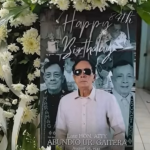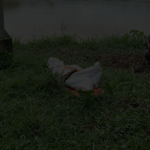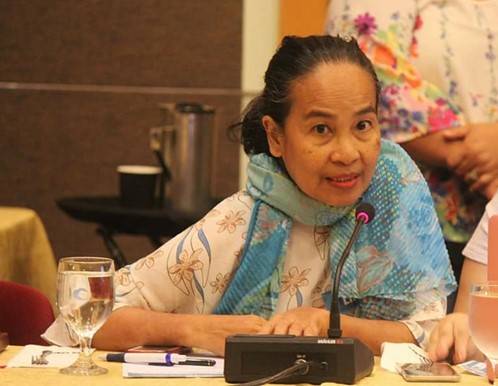MALAYBALAY CITY (Bukidnon News/30 January 2025)—It was a quick turn of events that led to the demise of the great Lina Sagaral Reyes.
On December 11, Wednesday, Lina wrote on Facebook that she was feeling “skeletal, spectral, and ghostly.”
On the 12th, her blood pressure dipped, her blood sugar spiked, and she couldn’t breathe. So she called for an ambulance from her solitary home in Cagayan de Oro, which rushed her to the JR Borja General Hospital and then to the ER of the state-run Northern Mindanao Medical Center.
In the evening, still on oxygen support, she was wheeled out of the ER to an alley right across the nurses’ station. All the wards were full. And despite being a non-smoker, her initial diagnosis was smoker’s lungs.
On the 13th, Lina wrote that she was “definitely feeling better.” “O2 saturation now 93. BP 100/80. Food is good,” she said. “Without a watcher of my own, the rest of the watchers of hospital patients are taking care of me. My community of journalists at COPC is supporting me. Even friends from afar are sending their gestures of support. I have certain concerns but I would rather not write about these until these are resolved. Gracias a la vida que me a hado tanto.”
On the 14th, Saturday, a neighboring patient’s watcher wrote on social media to look for her family. 63-year-old Lina had just died from cardiac arrest.
Hours later, her Manila-based sister Maria Yvette Reyes announced the wake (from Dec. 15 at St. Peter Memorial Chapels in Cagayan de Oro), cremation (Dec. 17), memorial service in Loay, Bohol (Dec. 19) and in Manila (January). In the days and weeks that followed, family and friends from the country’s literary and journalism circles took to social media to share their tributes and their grief.
“When such a one as Lina Sagaral Reyes passes to eternity,” wrote journalist Elizabeth Lolarga, “especially given her age (63), and with the knowledge that she could have done more, this grieves the community of writers no end.”
“It was difficult to write this,” feminist writer Pinky Serafica said, “because how do we write about you, Lina?”
ARS VITA
“Just before she brought herself to the hospital, she told me over Messenger that she lost her appetite,” said UP Diliman professor Dr. Ma. Diosa Labiste. “I said soup is an elixir to bring it back, so I suggested munggo, lentils, and the tried and tested Visayan fish soup, tinola/tinowa. Shortly after, she was posting photos of Palestinian food—yellow, perhaps pungent, and glistening with generous splashes of olive oil. I wish I were around to cook and plead that she takes a spoonful because she was visibly wasting away.”

This shot of the Palestinian flatbread zaatar manakish, which she tasted in her 2004 Jerusalem trip, was one of the last photos Lina shared online. (Photo origin unknown)
At the ER, the staff gave her some porridge so Diosa wired her some cash for food delivery: “She might be craving for curry or halang-halang (spicy coconut chicken soup, famous in Bohol).” Later that night Lina ate rice, steamed vegetables, and tuna paksiw.
Lina hails from Bohol, the small island-province in the Visayas that had not only gifted the country of its tasty dishes and its lengthy fiestas (there is a feast in town for each day of May) but also of its singers and boxers, actors and beauty queens, poets and rebels. Even the Boholano Carlos P. Garcia was an acclaimed poet or magbabalak before he became president of the republic.
Her town Loay, located at the mouth of the Loboc River, was where Rajah Sikatuna and Spaniard Miguel Lopez de Legaspi drank wine containing each other’s blood in 1565 in what was dubbed as the country’s first treaty. Her barangay Villalimpia was, in her words, “a village of blacksmiths, nipa thatchers, fishers, carpenters, a few teachers, sailors and other professionals, and women who live on their own.”


Left: The Sagaral Reyes residence in Villalimpia, 1963. Lina's father Ned was carrying her. Right: The Loay Labor Union with Lina's grandfather Gabriel Dolotina Sagaral as president (seated 5th from left), circa 1950s. (Photos from LSR's Facebook)
At a young age, Lina was a champion speller and essayist, bringing prestige to the Reyes family and exempting her from house chores. “[She had] a strong personality who lived a colorful life,” younger sister Yvette said. “I remember her as headstrong, but she also had a fragile side and nursed many insecurities about her writing.”
“From my perspective,” said poet and retired De La Salle University professor Marj Evasco, who belongs to the Reyes clan, “it is impossible to dichotomize one’s ars vita from one’s ars poetica…Lina lived her poetry before she wrote them.”
Both growing up in Bohol, their families frequented the Loay beach. “Before and after the swim, we’d go to Tio Ned’s and Tia Monica’s house, where the snacks and lunch would be prepared,” Marj said. They reunited in 1978 when Lina moved to Dumaguete to study English (Creative Writing) and journalism at the Silliman University, where Marj was with her family, doing her master’s. “She’d often visit and eat with us after school or sleep over on weekends and holidays…”
Aside from writing features for The Weekly Sillimanian, she, Marj, and other students formed the writers’ group Lunhaw (green). When they won the Annual Arinday Literary Awards, they pooled their money to pay for a tartanilla (horse-drawn carriage) to ride around the city while eating banana or camote cue. “She had a zest for these simple pleasures,” said Marj.
The turf of the Tiempo literary couple, the 62-hectare Silliman has honed scores of writers who enriched Philippine literature especially with the annual Silliman University National Writers Workshop—the first of its kind in Asia—which the duo established in 1962. Both National Artist for Literature Edith Tiempo and fictionist husband Edilberto mentored Lina.
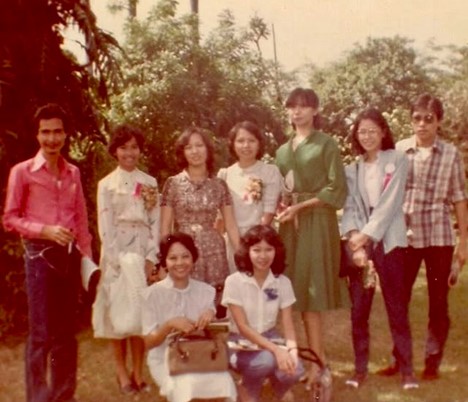
Lina (2nd standing) and Marj (4th) with their Sillimanian peers in the late 70s. (Photo from thediarist.ph)
One of her avid readers was Sansen Lee Vendiola, whose interest was piqued when a veteran broadcaster who judged a city-wide essay writing contest had praised her and a nother student on the radio for showing “depth beyond their age” and writing talent “far superior to all other essay writing contestants, including professionals and mature adults.”
While forming an opposition party for the Silliman University Student Government, she tapped Sansen to run with her. They both won, with Lina becoming Silliman’s first female student council president. “She was tiny but formidable,” he said. “Her soft-spoken, calm demeanor during stressful political decision-making helped temper my often bombastic and confrontational type of leading and negotiating.”
Of her sister’s demeanor, Yvette’s take is more nuanced: “She had quite a temperament, but she had humility, too. She was a mixture of many things. When she found a cause, she was passionate about it.”


Left: Lina in late 80s. Right: 'Storya, published in 1993 by the Babaylan Women's Publishing Collective of St. Scholastica's College, which until last year was an all-girls school. (Photos from thediarist.ph)
…ARS POETICA
“I met Lina at the tail of a daydream,” said Manila–based Pinky Serafica. “She was on one end of the passage near the College Canteen in La Salle-Taft, oblivious. And I was already near the old library going to the pebble wash, also oblivious. The tinkling of many bells stopped me from daydream-walking and I looked behind to see this short-haired woman, in malong and with tens of T’boli-made bells and bracelets around her ankles and arms, gliding.” The two looked at each other as they moved, breaking protocol, amidst students and faculty who stopped to listen to the prayer broadcast. As the two revolved in the same literary and feminist circles, they soon became friends.
This was the mid-1980s when Lina, after Silliman, began teaching at the De La Salle University in Manila, at a time when the country was on the brink of upheaval. The previous decade, then President Ferdinand Marcos Sr. placed the country under Martial Law, and while it was officially repealed in 1981, the rounding up of activists, journalists, and politicians continued and so did the people’s movements.
University of the Philippines film professor Rolando Tolentino, then on his third year studying economics and accounting in La Salle, met Lina in one of the protests. They both went to the people’s concert mourning the killing of Senator Benigno “Ninoy” Aquino Jr. One time, after a workshop in Rajah Sulayman, the two shared one bibingka— “hating-kapatid” style (sharing among siblings)—at the Fort Santiago. Two policemen saw Lina cut it with her mini-balisong (butterfly knife), insisted it’s a deadly weapon, and emptied their wallets save for a few pesos for transportation.
The two also joined the Edsa People Power Revolution in 1986, which toppled Marcos’s 21-year dictatorship. In 1987, a year into President Corazon Aquino’s term, Rolando attended the farmers’ protest that turned into the Mendiola massacre. He went to Lina’s house to cool down as her sister fed him a bowl of steaming pork nilaga. When she arrived from work, Lina let him recall what happened. “Nagalit at naiyak ka rin,” Rolando said. “Wala ka halos sinabi, hiniyaan mo akong magkwento.” ([Lina] also got angry and cried. She almost did not say anything and just allowed me to speak.)
But then, around the same time, Lina’s doctor diagnosed her with leukemia and gave her six months to two years left to live. “[This] started her manic-depressive reactions,” Sansen said. According to Ronaldo, Lina would be found giggling suddenly about something and at times when she would suddenly shut off. A colleague saw her fling all her stuff from the top floor of a building then shortly picked them up and fled.
“But she tried to overcome her mental anguish and emotional turmoil by writing…” said Sansen. “She became a prolific poet to vent out her negative emotions, to fight for what is right, and for the rights of the marginalized.”
Lina returned that year to Villalimpia and turned her parents’ house into the Center for Creative Women, where she began compiling the lives of the women in the village.



Left: Yvette, Lina, and their sisters in the late 90s. (Photo from LSR's FB) Top right: The Loay Beach.(From myproperty.ph) Bottom right: Drone shot of the Loboc River. (istockphoto.com)
“Her poetry recorded in luminous language the lives of the women, men and children of Villalimpia,” said Marj. “These poems as well as Lina’s life and death will remain vital to the consciousness of many women-who-write, who have been indelibly moved by her bravery in the practice of art and activism.”
Adonis Durado, associate professor for visual communications at Ohio University, who met Lina at the 1990 College Editors Guild convention in Aklan, said: “What I love most about Lina’s poetry is its homespun, intimate quality. Reading her work feels like unwrapping a meal bundled in banana leaves or walking barefoot along a sandy beach. Her words are earthy, grounding, and deeply nourishing. Lina’s poetry bridged the personal and the political with a rare honesty, never losing its heart.”
In 1987, 26-year-old Lina bagged the 1st prize of the prestigious Palanca Awards for Literature for her poetry anthology “(Instead of a Will These) For All the Loved Ones.” She also published the anthology, Honing Weapons, which she gifted Sansen during her trip to Canada in 1998, when she had long recuperated, far outliving her doctor’s prognosis.
Tree Without Leaves
By Lina Sagaral Reyes
How your leaving unleafed me.
Wide wide lakes of leaves,
The crackle of breaking
Underfoot.
Memory became a bare crown
Of boughs as taut as the dark-eyed
Nipples of women
Facing the honest mirror of fears.
“You have strength I can’t name,”
Once you told me.
Now you must
Know: as winds churn
The leaf-lakes below,
I stand
Rooting with the power
You knew
and named Nameless.
On the rough nodes of my evening
Fireflies nestle,
Blooming.
#
In 1990, she won another Palanca, this time a 3rd prize for Istorya, which she later published as an anthology entitled ‘Storya in 1993.
“It became my introduction to how poetry could weave societal and political themes without becoming heavy-handed or didactic,” Adonis said of the first poetry book he ever purchased. “For me, her writing—masterful and nuanced—stood on par with that of Wislawa Szymborska. Lina’s work taught me how poetry could be both deeply personal and profoundly political, shaping my own writing in ways I’m still discovering.” His latest poetry collection, Tabyog Sa Way Kinutoban (Swinging Without End), was dedicated to both her and Marj.
But then, in a quick turn of events, Lina decided to change careers to journalism.
In the 2012 Davao Writers Workshop, 51-year-old Lina who was a panelist in poetry said, “I come home to the community ritual of writers: for the fellows, a rite of passage; for the panelists, the rite of relaying wisdom (as well as folly) to the next generation.
“It has been a long journey home. This is my first ever workshop in 19 years. The last workshop I attended was held in UP-Baguio in May 1993. On my way home to the island of Bohol via Manila…I did not have an inkling that in eight months, I would find myself in the shores of Dapitan, Zamboanga del Norte.”
…ARS JOURNALISTICA
If you ask Baguio-based journalist Frank Cimatu on his friend’s career shift, he will say it’s caused by “a heartbreak over a Baguio boy.”
“The members of the Philippine Literary Arts Council were always in Baguio,” he said. “…So Lina was right smack in things, always with the Cordillera Women Education and Research Center and the women’s groups. There were lots of readings then.”
Lina became involved with “a prominent artist who was a party boy.” “We often drank at Rumours and other places,” Frank said. “I wasn’t surprised that they became an item. [But] it proved fatal for her. Then she disappeared and reinvented herself as a journalist.”
At her 50th birthday celebration in Cagayan de Oro, Frank begged her to return to poetry: “Maybe forsake journalism where she was reaping awards already.”
In 1994, Lina landed her first newspaper job at Zamboanga’s Press Freedom, whose editor Ferdinand Reyes was later killed. She shortly moved to Cagayan de Oro to the Women’s Feature Service where she met Diosa and reunited with her La Salle friend Pinky. Lina’s feature “Bantayan: Island in Peril,” an exposé on an international resort’s sand dredging operations that disrupted the local ecosystems, published in Mr. and Ms. magazine (the Inquirer precursor), won 3rd prize in the 1995 Jaime V. Ongpin Award for Investigative Journalism.
Her other accolades were the 2000 National Science and Technology Journalism Grand Prize for her investigative story of an algal bloom in Macajalar Bay in Misamis Oriental, caused by unregulated agro-industrial developments and the 2020 Globe Media Excellence Awards for her investigative reporting on big pineapple plantations where she scrutinized their negative-carbon footprint claims. She also received Xavier University’s Lambago Art Awards in 2016 and 2018.
Through the years, she had worked as a correspondent for the Philippine Daily Inquirer, Manila Times, SunStar Cagayan de Oro, Mindanao Gold Star Daily, and Bukidnon News.
“Beyond her investigative prowess, Reyes had a gift for weaving narratives that humanized complex issues,” said journalist Editha Z. Cadauya. “Her pieces often spotlighted the stories of women, indigenous communities, and other marginalized groups whose voices were often drowned out in mainstream media…Her work will continue to inspire future generations of journalists to pursue stories that matter, to hold the powerful accountable, and to never shy away from difficult truths.”
In 2004, Lina’s trip to Jerusalem with Yvette widened her understanding of the Palestinian struggle. She saw how the Security Wall, which was just being built on top of demolished houses and olive trees, began to alienate the Palestinians in West Bank. She also met Prof. Nadera Shalhoub-Kevorkian of the Hebrew University, who discovered in her research that some Palestinian girls, Muslims and Christians alike, wished to become shaheeds, martyrs-in-waiting or would-be suicide bombers. “The Security Wall impinged on [their] lives…” Lina wrote. Palestinian girls who are schooled in Jerusalem but lived in the outskirts of the city or in the West Bank had to go through the daily routine of “inspection at the checkpoints, closures, roadblocks, harassment, and sometimes, blatant abuse.”
Thousands of miles away in Canada, Sansen read Lina’s other writings on “the disadvantages of being female; the destruction of a town in her home-province of Bohol due to the mining of limestone; the exploitation of indigenous peoples in Mindanao, especially women and children; the farming and fishing practices of indigenous peoples; indigenous and local arts; the effects of climate change (way before “climate change” became part of people’s vocabulary); the effects of isolation and living alone, or being an unmarried woman; folk medicine; mental health.” While Pinky would always ask about her poetry every time she submits a journalistic piece in Women Writing Women. “That is her home,” Pinky said, “and she’d say there were many, but they were raw, unfinished.”
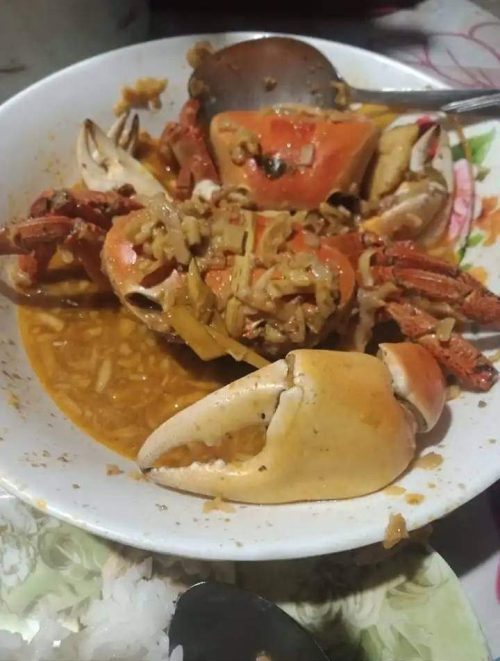
This photo of a crab dish was featured in one of Lina's latest writing, "Nilaming nga kagang, nilubihan /Pikas-Mata, the One-Eyed Kagang." (Photo by Exequiel Araneta Johnson, Jr)
One of the last stories she submitted is about the dish of mud crab cooked in thick coconut milk by her father in 1972, when she was 11 years old at the start of Martial Law. Most recently, she was working on a project for the Cagayan de Oro Press Club, one of the country’s oldest media organizations where she was Journalism Institute director. The project was given a million-peso grant by the National Commission for Culture and the Arts.
But then, last December, in a quick turn of events, Lina perished at the hospital lobby in the company of strangers-turned-fast friends as her family and old friends were so far away. Rolando would have met her in November when he visited CdeO, if only she was not feeling sick that day. Another Silliman friend, University of San Carlos mathematics professor Enriqueta Reston travelled from Cebu to Cagayan de Oro that fateful Saturday to go to the hospital, only to be led to Lina’s wake.
In her tribute, Pinky wrote, “Thank you for you, sis, and your friendship and life reminder that we are raw, messy, unfinished, vulnerable, sometimes brave.”
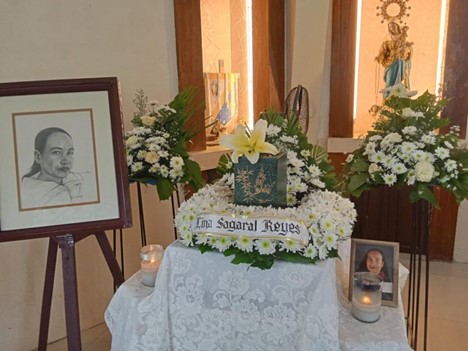
Lina’s memorial at the chapel in Villalimpia. (Photo from thediarist.ph)
#


